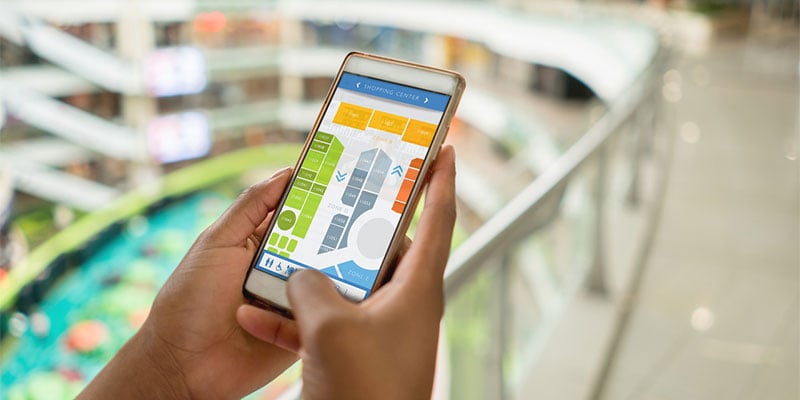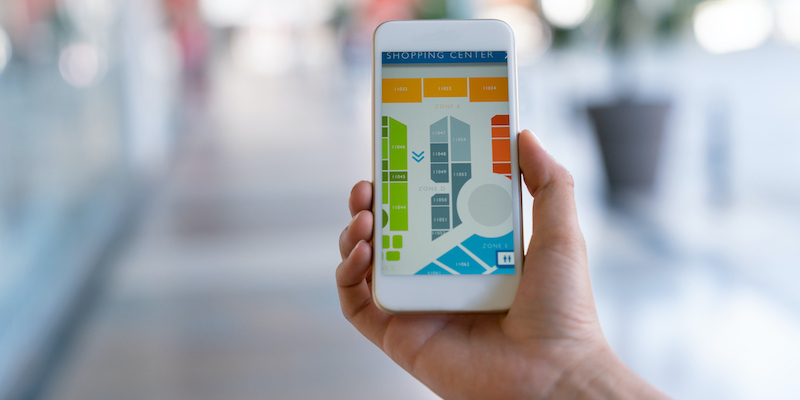 Location technology has conditioned people to rely on digital maps and smartphone apps to guide them to and from destinations both familiar and foreign. The behavior has become so second nature that planners of large shopping centers and related retailers are bringing similar technology indoors to transform the shopper experience.
Location technology has conditioned people to rely on digital maps and smartphone apps to guide them to and from destinations both familiar and foreign. The behavior has become so second nature that planners of large shopping centers and related retailers are bringing similar technology indoors to transform the shopper experience.
Orienting Space
Indoor location technology helps users orient themselves to their surroundings, not unlike the outdoor navigation with which they are accustomed. However, instead of road map data, detailed digitized floor plans of a shopping center appear on their devices. It may reflect the floor the user is on, the store they’re in, and perhaps the general direction in which they’re traveling. Depending on the smartphone app, there may even be some geospatial features that offer map turn-by-turn navigation so shoppers can “see themselves” on-screen, usually represented by a moving dot or a dashed line.1
It’s all done with the intent of helping shoppers place themselves within a large complex (think Mall of America) and quickly finding their way to the store they want relative to their actual physical location, saving time and frustration. Some malls even integrate indoor mapping and intelligent parking technology to guide shoppers to the lots and spaces closest to their preferred stores so they can seamlessly get into the mall and to the items they want.1
Location, Location, Location
Once shoppers are in the mall, how do retailers leverage indoor mapping to sway store traffic and sales?
Aisle411, a global leader in retail space navigation, is an often-used solution. The consumer service creates immersive customer experiences through a combination of advanced technologies and analytics.
The app’s searchable digitized maps help shoppers find and pinpoint the location of desired items in-store. On the retailer side, that same map gathers KPIs and other analytics to optimize store inventory and floor plans based on customer and associate behavior, popular customer draws, and product placement.2 Aisle411 uses augmented reality — a combination of geographic information systems (GIS), virtual reality, and location technology — to reach the 80% of shoppers who use their smartphones while shopping, pushing out real-time messages that deliver retailers a 20X increase in customer purchase intent.2
With statistics like those reported by Aisle411, indoor mapping is understandably gaining popularity with retailers, but this relatively new technology isn’t reserved exclusively for this space. Healthcare facilities, office complexes, university campuses, casinos, theme parks, museums3 — almost any large facility that draws foot traffic — are being equipped with location technology capabilities to direct people through their interiors. Even older buildings, thanks to the Internet of Things (IoT), are being retrofitted with geospatially digitized indoor maps.4
How can you use indoor mapping to manage how customers experience your space and influence their behaviors once there? Contact ADCi today to learn more.
SOURCES
1Jibestream, 10 Essential Features Indoor Wayfinding Adds to Your Shopping Mall App, November 8, 2018
2Aisle411 website
3Carto, Make Data Count, webinar, undated
4Geo Awesomeness, How indoor mapping is going to change lives in 2019, January 14, 2019
Subscribe to ADCi's Blog
Related Posts

Why Supply Chain Mapping Is Critical in 2021

COVID-19 Safety: How Indoor Positioning Can Enable Social Distancing

